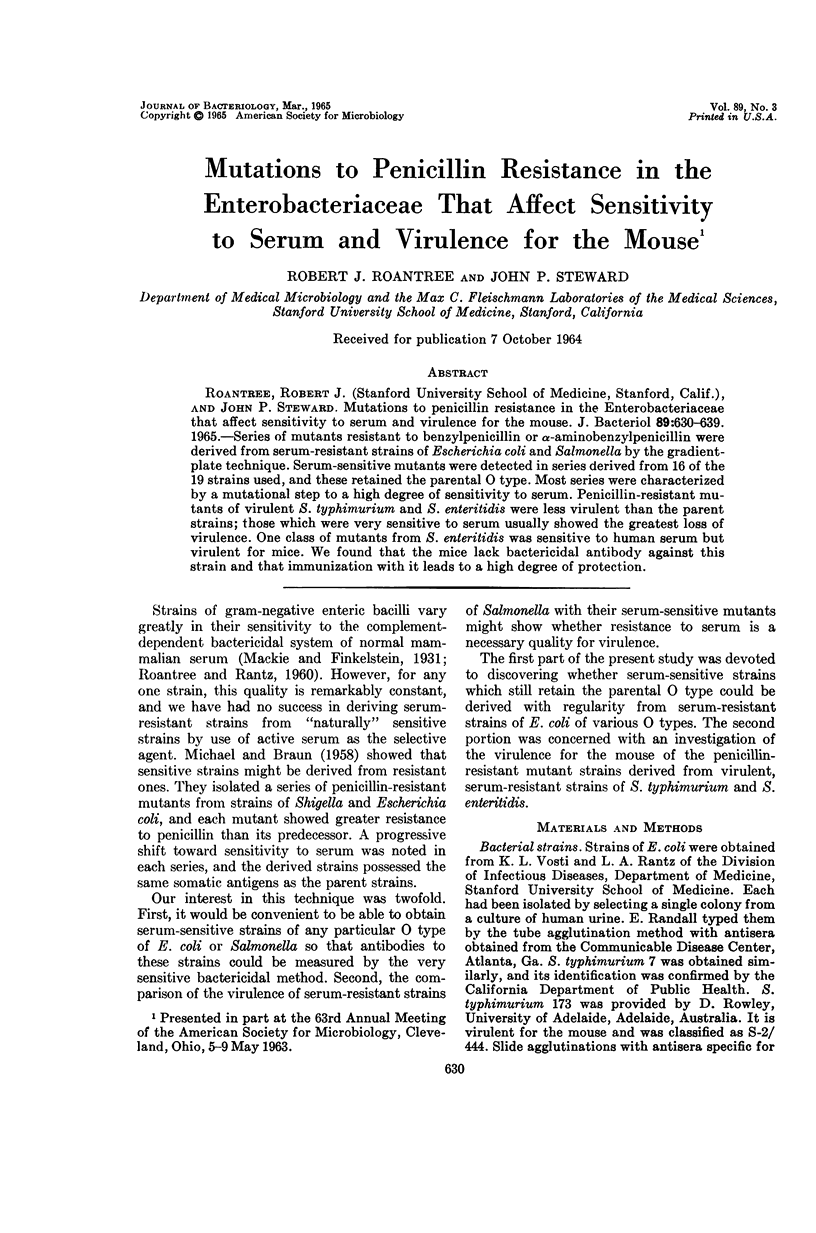Abstract
Roantree, Robert J. (Stanford University School of Medicine, Stanford, Calif.), and John P. Steward. Mutations to penicillin resistance in the Enterobacteriaceae that affect sensitivity to serum and virulence for the mouse. J. Bacteriol 89:630–639. 1965.—Series of mutants resistant to benzylpenicillin or α-aminobenzylpenicillin were derived from serum-resistant strains of Escherichia coli and Salmonella by the gradientplate technique. Serum-sensitive mutants were detected in series derived from 16 of the 19 strains used, and these retained the parental O type. Most series were characterized by a mutational step to a high degree of sensitivity to serum. Penicillin-resistant mutants of virulent S. typhimurium and S. enteritidis were less virulent than the parent strains; those which were very sensitive to serum usually showed the greatest loss of virulence. One class of mutants from S. enteritidis was sensitive to human serum but virulent for mice. We found that the mice lack bactericidal antibody against this strain and that immunization with it leads to a high degree of protection.
Full text
PDF









Selected References
These references are in PubMed. This may not be the complete list of references from this article.
- BECKMANN I., SUBBAIAH T. V., STOCKER B. A. ROUGH MUTANTS OF SALMONELLA TYPHIMURIUM. II. SEROLOGICAL AND CHEMICAL INVESTIGATIONS. Nature. 1964 Mar 28;201:1299–1301. doi: 10.1038/2011299a0. [DOI] [PubMed] [Google Scholar]
- Banic S. Transduction to Penicillin and Chloramphenicol Resistance in Salmonella Typhimurium. Genetics. 1959 May;44(3):449–455. doi: 10.1093/genetics/44.3.449. [DOI] [PMC free article] [PubMed] [Google Scholar]
- HOBSON D. The behaviour of a mutant strain of Salmonella typhimurium in experimental mouse typhoid. J Hyg (Lond) 1957 Sep;55(3):322–333. doi: 10.1017/s0022172400037232. [DOI] [PMC free article] [PubMed] [Google Scholar]
- HOTCHKISS R. D. Transfer of penicillin resistance in pneumococci by the desoxyribonucleate derived from resistant cultures. Cold Spring Harb Symp Quant Biol. 1951;16:457–461. doi: 10.1101/sqb.1951.016.01.032. [DOI] [PubMed] [Google Scholar]
- LUEDERITZ O., KAUFFMANN F., STIERLIN H., WESTPHAL O. [On the immunochemistry of O antigens of enterobacteriaceae. II. Comparison of the sugar componet of the S. R and T forms of Salmonella]. Zentralbl Bakteriol. 1960 Jun;179:180–186. [PubMed] [Google Scholar]
- MARCUS S., ESPLIN D. W., DONALDSON D. M. Lack of bactericidal effect of mouse serum on a number of common microorganisms. Science. 1954 Jun 18;119(3103):877–877. doi: 10.1126/science.119.3103.877. [DOI] [PubMed] [Google Scholar]
- MICHAEL J. G., BRAUN W. Relationships between bacterial resistance to serum and penicillin. Proc Soc Exp Biol Med. 1958 Jan;97(1):104–107. doi: 10.3181/00379727-97-23658. [DOI] [PubMed] [Google Scholar]
- MICHAEL J. G., BRAUN W. Serum spheroplasts of Shigella dysenteriae. Proc Soc Exp Biol Med. 1959 Feb;100(2):422–425. doi: 10.3181/00379727-100-24649. [DOI] [PubMed] [Google Scholar]
- MUSCHEL L. H., CAREY W. F., BARON L. S. Formation of bacterial protoplasts by serum components. J Immunol. 1959 Jan;82(1):38–42. [PubMed] [Google Scholar]
- Michael J. G., Braun W. Analysis of sequential stages in serum bactericidal reactions. J Bacteriol. 1964 May;87(5):1067–1072. doi: 10.1128/jb.87.5.1067-1072.1964. [DOI] [PMC free article] [PubMed] [Google Scholar]
- PARK J. T., STROMINGER J. L. Mode of action of penicillin. Science. 1957 Jan 18;125(3238):99–101. doi: 10.1126/science.125.3238.99. [DOI] [PubMed] [Google Scholar]
- ROGERS H. J., MANDELSTAM J. Inhibition of cell-wall-muco-peptide formation in Escherichia coli by benzylpenicillin and 6-[D(-)-alpha-aminophenylacetamido]penicillanic acid (ampicillin). Biochem J. 1962 Aug;84:299–303. doi: 10.1042/bj0840299. [DOI] [PMC free article] [PubMed] [Google Scholar]
- ROWLEY D. Rapidly induced changes in the level of non-specific immunity in laboratory animals. Br J Exp Pathol. 1956 Jun;37(3):223–234. [PMC free article] [PubMed] [Google Scholar]
- ROWLEY D. The virulence of strains of Bacterium coli for mice. Br J Exp Pathol. 1954 Dec;35(6):528–538. [PMC free article] [PubMed] [Google Scholar]
- Roantree R. J., Rantz L. A. A STUDY OF THE RELATIONSHIP OF THE NORMAL BACTERICIDAL ACTIVITY OF HUMAN SERUM TO BACTERIAL INFECTION. J Clin Invest. 1960 Jan;39(1):72–81. doi: 10.1172/JCI104029. [DOI] [PMC free article] [PubMed] [Google Scholar]
- STEWARD J. P., COLLIS L. R., ROANTREE R. J. EFFECTS OF ACTIVE IMMUNIZATION AND OF TOTAL BODY X-IRRADIATION UPON THE HUMORAL BACTERICIDAL SYSTEM OF THE GUINEA PIG AS MEASURED WITH STRAINS OF ENTERIC BACILLI. J Immunol. 1964 Apr;92:616–625. [PubMed] [Google Scholar]
- STEWARD J. P., ROANTREE R. J. Effect of mouse peritoneal fluid on strains of enteric bacilli. Proc Soc Exp Biol Med. 1961 Dec;108:654–658. doi: 10.3181/00379727-108-27025. [DOI] [PubMed] [Google Scholar]
- SZYBALSKI W., BRYSON V. Genetic studies on microbial cross resistance to toxic agents. I. Cross resistance of Escherichia coli to fifteen antibiotics. J Bacteriol. 1952 Oct;64(4):489–499. doi: 10.1128/jb.64.4.489-499.1952. [DOI] [PMC free article] [PubMed] [Google Scholar]
- Thjøtta T., Waaler E. Dissociation and Sensitiveness to Normal Serum in Dysentery Bacilli of Type III. J Bacteriol. 1932 Oct;24(4):301–316. doi: 10.1128/jb.24.4.301-316.1932. [DOI] [PMC free article] [PubMed] [Google Scholar]
- WEIDEL W., FRANK H., MARTIN H. H. The rigid layer of the cell wall of Escherichia coli strain B. J Gen Microbiol. 1960 Feb;22:158–166. doi: 10.1099/00221287-22-1-158. [DOI] [PubMed] [Google Scholar]


